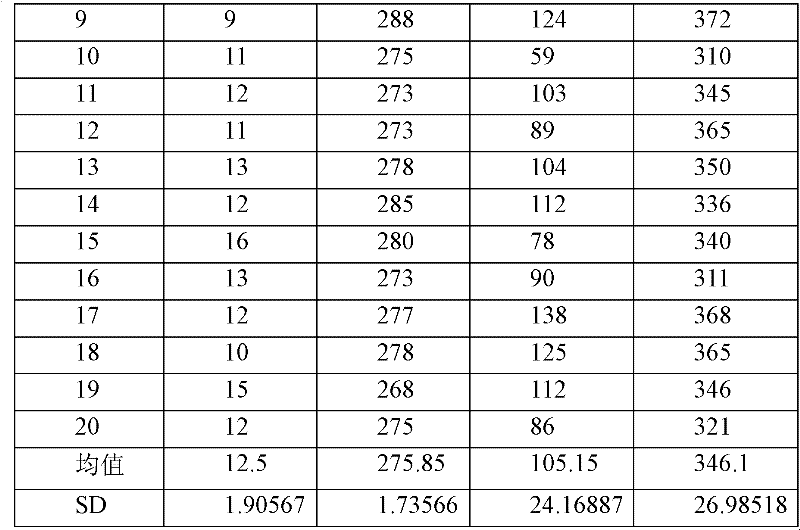Method and reagent for latex sensitization
A latex and reagent technology, applied in the field of latex-enhanced immune turbidimetric reagents, can solve problems such as long time, loss of antigen or antibody activity, sensitivity impact, etc., to save time, improve detection sensitivity, and enhance clinical application value.
- Summary
- Abstract
- Description
- Claims
- Application Information
AI Technical Summary
Problems solved by technology
Method used
Image
Examples
Embodiment 1
[0045] Example 1: Binding of Latex to Unrelated Proteins
[0046] raw material:
[0047] Carboxyl-modified polystyrene latex, particle diameter 124nm, concentration 10% (weight to volume ratio), surface carboxyl content 100 μ mol / g.
[0048] EDAC (analytical grade, sigma) was dissolved in double-distilled water to prepare a 5 mg / ml solution, which was prepared half an hour before use.
[0049] With 10mM MES, pH6.1 damping fluid is diluted latex solution to 0.5% (weight volume ratio), then adds BSA solution, makes the concentration of BSA in the system reach 200ug / ml, finally adds the EDAC solution of 5mg / ml, makes EDAC When the concentration in the system reaches 75ug / ml, the reaction starts. A constant temperature water bath was used to keep the reaction temperature at 37° C. and the reaction time was 3 hr. After the reaction, centrifuge (12000rpm, 30min), then add the initial same amount of 0.1M PBS, pH7.4 buffer solution, and ultrasonically in ice bath to disperse the la...
Embodiment 2
[0050] Embodiment 2: Preparation of sensitized latex
[0051] To the unrelated protein-bound latex solution in Example 1 was added streptolysin O antigen. The streptolysin O antigen used is a gene recombination product. The concentration of the added antigen in the system was 100ug / ml. Then add 2% glutaraldehyde aqueous solution to start the reaction, the addition ratio is 0.002%. The reaction temperature is 25°C, the reaction time is 3hr, after the reaction is over, centrifuge (12000rpm, 30min), then add the same amount of 0.1M glycine at the beginning, pH8.4 buffer solution, ice bath ultrasonication, to disperse the latex, centrifuge again, and the latex Disperse in 0.1M glycine containing 0.5% (weight to volume ratio) BSA, and store in pH 8.4 buffer.
Embodiment 3
[0052] Example 3: Preparation of Antistreptolysin O Latex Enhanced Immunoturbidimetric Reagent
[0053] The specific composition of antistreptolysin O latex enhanced immune turbidimetric reagent is as follows:
[0054] Reagent R1: Glycine buffer 0.1M pH8.4
[0055] NaCl 300mM
[0056] Tween 20 0.1% (weight to volume ratio)
[0057] PEG6000 1% (weight to volume ratio)
[0058] NaN 3 0.1% (weight to volume ratio)
[0059] Reagent R2: Glycine buffer 0.1M pH8.4
[0060] Allergen latex (prepared in embodiment 2) 0.17% (weight to volume ratio)
[0061] BSA 0.5% (weight to volume ratio)
[0062] NaN 3 0.1% (weight to volume ratio).
[0063] The control is a commercially available imported reagent A, the information of which is as follows:
[0064] Product Name: Anti-Streptococcal O Detection Kit (Immunoturbidimetric Assay)
[0065] Principle: The ASO in the sample reacts with the hypersensitized latex particle reagent to form an immune complex, and the c...
PUM
| Property | Measurement | Unit |
|---|---|---|
| Particle size | aaaaa | aaaaa |
Abstract
Description
Claims
Application Information
 Login to View More
Login to View More - R&D
- Intellectual Property
- Life Sciences
- Materials
- Tech Scout
- Unparalleled Data Quality
- Higher Quality Content
- 60% Fewer Hallucinations
Browse by: Latest US Patents, China's latest patents, Technical Efficacy Thesaurus, Application Domain, Technology Topic, Popular Technical Reports.
© 2025 PatSnap. All rights reserved.Legal|Privacy policy|Modern Slavery Act Transparency Statement|Sitemap|About US| Contact US: help@patsnap.com



